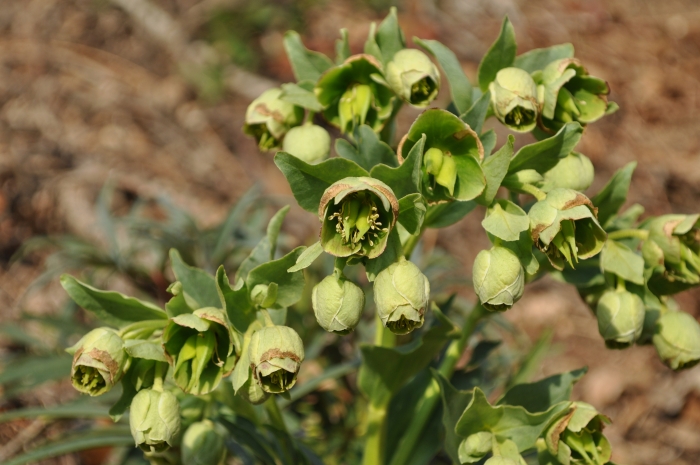Stinking Hellebore
(Helleborus foetidus)
Stinking Hellebore (Helleborus foetidus)
/
/

Josep Gesti
CC BY-SA 4.0
Image By:
Josep Gesti
Recorded By:
Copyright:
CC BY-SA 4.0
Copyright Notice:
Photo by: Josep Gesti | License Type: CC BY-SA 4.0 | License URL: https://creativecommons.org/licenses/by-sa/4.0 | Uploader: Josepgesti | Publisher: Wikimedia Commons | Title: Helleborus_foetidus,_Santa_Coloma_de_Farners_02.jpg | Notes: Uploaded own work with UploadWizard |













































































Estimated Native Range
Summary
Helleborus foetidus, commonly known as Stinking Hellebore or Setterwort, is an evergreen perennial herb native to the chalky, limestone woodlands of Western and Central Europe. It typically grows to 80 cm (31 in) tall and 100 cm (39 in) across, featuring a thick succulent stem and glossy, leathery leaves that are divided into narrow, finger-like segments. The drooping, cup-shaped flowers, which appear in late winter to early spring, are yellowish-green, often with a purple edge to the five petal-like sepals, and are borne on strongly upright stems. The flowers are subtly showy and contain numerous stamens and up to ten nectaries, making them attractive to bees and other pollinators. Each flower can produce up to five wrinkled follicles, typically three.
Stinking Hellebore is valued for its handsome evergreen foliage and the large numbers of green, bell-shaped flowers that provide early-season interest. It is often used in shaded garden borders, woodland gardens, and as underplanting for deciduous shrubs. The plant is drought-tolerant once established and prefers deep, fertile, moist, humus-rich, well-drained soil. It thrives in dappled shade but can tolerate full shade. Propagation is by division or from seed, which can be prolific, allowing the plant to naturalize in ideal conditions. Popular cultivars include ’Green Giant’ with bright green flowers, ’Miss Jekyll’ with fragrant flowers, ’Wester Flisk Group’ with red-tinted leaves and stems, and the dwarf ’Sierra Nevada Group’ reaching only 30 cm. Potential problems include black death, a virus that causes black streaking on the leaves and can be fatal, and leaf spot diseases.CC BY-SA 4.0
Stinking Hellebore is valued for its handsome evergreen foliage and the large numbers of green, bell-shaped flowers that provide early-season interest. It is often used in shaded garden borders, woodland gardens, and as underplanting for deciduous shrubs. The plant is drought-tolerant once established and prefers deep, fertile, moist, humus-rich, well-drained soil. It thrives in dappled shade but can tolerate full shade. Propagation is by division or from seed, which can be prolific, allowing the plant to naturalize in ideal conditions. Popular cultivars include ’Green Giant’ with bright green flowers, ’Miss Jekyll’ with fragrant flowers, ’Wester Flisk Group’ with red-tinted leaves and stems, and the dwarf ’Sierra Nevada Group’ reaching only 30 cm. Potential problems include black death, a virus that causes black streaking on the leaves and can be fatal, and leaf spot diseases.CC BY-SA 4.0
Plant Description
- Plant Type: Herb
- Height: 1-2 feet
- Width: 1-1.5 feet
- Growth Rate: Moderate
- Flower Color: Cream, Green
- Flowering Season: Winter, Spring
- Leaf Retention: Evergreen
Growth Requirements
- Sun: Part Shade, Full Shade
- Water: Medium
- Drainage: Slow, Medium, Fast
Common Uses
Bee Garden, Deer Resistant, Drought Tolerant, Fragrant, Groundcover, Low Maintenance, Rabbit Resistant, Rock Garden, Street Planting
Natural Habitat
Chalky, limestone woodlands of Western and Central Europe
Other Names
Common Names: Stinking Hellebore, Bear’s-Foot, Dungwort, Stinkende Nieswurz, Ellébore Fétide, Pied De Griffon, Hellébore Fétide, Stinkend Nieskruid, Grenig Julros, Stinkande Prustrot, Klockjulros
Scientific Names: , Helleborus foetidus, Veratrum helleboraster,
GBIF Accepted Name: Helleborus foetidus L.